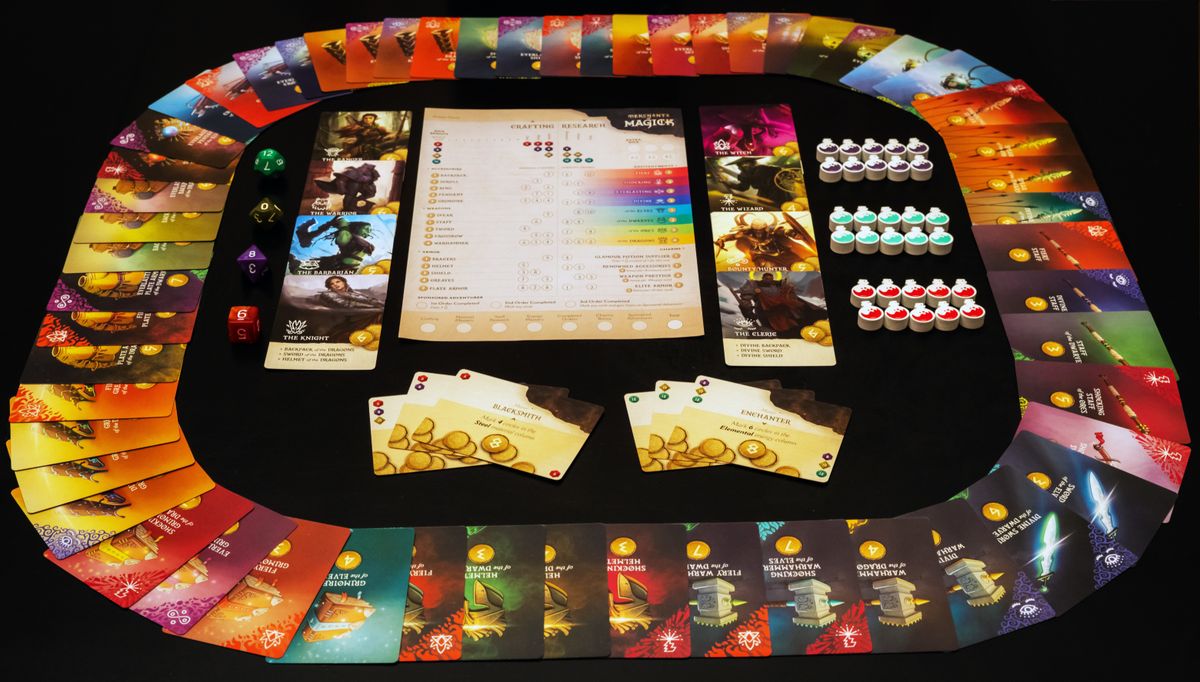Satisfy the Needs of Choosy Adventurers in Merchants of Magick

This roll and write from designer Clarence Simpson places 1-8 players in the role of merchants diligently working to craft equipment for would-be warriors.
Gameplay
Merchants of Magick is set in the same universe as previous Rock Manor Games release, Set a Watch. The object of the game is to earn the most coins for crafting needed accessories, weapons, and armor for adventures as they prepare to battle the vicious Unhallowed.
Merchants of Magick takes place over 10 fast-paced rounds, each with four phases, where everyone is simultaneously working to fulfill orders. Play begins with each player taking a sheet, which helps players keep track of what has been rolled and how they choose to allocate those dice. Two mastery cards will be chosen (one including one of the crafting materials and the other with one of the available enchantments) that are goals for players to complete. Players will draft a sponsored adventurer, who has 3 items they want crafted that can only be fulfilled by the player who drafts that hero. Each player will also have up to 4 item cards (depending on player count) in front of them, each depicting particular identifiers and objects to craft. The first player for the round will gather the four dice (D6, D8, D10, and D12) and roll them. Players will note the face value of each in the top left corner of their sheets.
The purpose of each die is to help players begin the process of crafting the items and enchantments necessary to fulfill the item cards and the sponsored adventurer needs. This is the resource phase. Players can choose two of the dice to use per round during the research phase, so they must choose carefully. For example, a pendant may require two different values to complete under the wood and leather columns. Players can only use certain dice and values (a bubble with a number will also include an up or down arrow to specify that numbers equal to or higher/lesser than the shown value will fulfill that bubble’s parameters) in meeting these requirements. It may be that the dice values shown do not fit into the two bubbles a pendant needs for completion in the same round. There are also other requirements to chase, such as being able to craft items for elves or dragons, or that are shocking or divine. It’s up to each player how to leverage the two dice values they choose for the round.
It can take many rounds to be able to fill in all the bubbles for an item or enchantment, but once you have learned how to craft it, you will know that skill for the rest of the game and begin claiming item cards that match what you have learned. Completing items or enchantment rows will also award a potion. Potions can be used to manipulate the pip value on dice (which may be necessary to complete some items and enchantments) or they can be used to allow you to choose an extra die from what has been rolled to fill in additional bubbles during a round.
As players are able to craft items and enchantments, they will begin to fulfill the needs of their sponsored adventurer. Meeting one need will award players 3 potions, meeting the second need will give players the chance to fill in one of any bubble on their sheet, and the last one will allow players to fill in another bubble anywhere on their sheet as well as earn the coins the adventurer is worth.
Next is the Mastery phase, where players will see if anyone has fulfilled the requirements of the Mastery cards. If so, they may score the card and then flip it over to the apprentice side for other players to fulfill at a lower point value. Finally is the Customer phase, where players place new item cards face down into their queue and pass the card on their furthest right clockwise.
After 10 rounds, players will count up the coins they’ve earned for completing crafts and enchantments, the points for completed orders, the points for completing the sponsored adventurer card, and any applicable points for bonuses. The player with the highest coin total is declared the winner.

Merchants of Magick components — image by designer Clarence Simpson
Review
Despite the breadth of the game’s initial teach, Merchants of Magick is a very easy-to-play and relaxing roll-and-write experience. Though it can be competitive in bigger game settings, the ability to sit and think how dice will be allocated, when and how to use potions, and what is best to craft long-term add some thinking elements to the genre.
The graphic design and art from Boris Stanisic and T.L. Simons is eye-catching as well. In its simplicity there is beauty. The paper sheets are colorful — almost to a detriment on the enchantments side of the paper, making it hard to see which spells have been completed when you circle the coin value. The item cards are colorful, fanciful, and great to look at. The symbology is easy to discern and works well against the pastel palette of the cards.
The solo variant is great, as well. The changes are few (largely centered around how the item market works) but keep the game engaging for those who want a solo challenge when others are unable to join them.
The only negative take away from Merchants of Magick is the rulebook. It can be a difficult read when players are starting out, trying to understand how the sheet works, and how all the elements come together. A few more pictures showing the order of operations may help those who are more visually inclined when learning games, but Rock Manor’s founder Mike Gnade has a handy YouTube video for those who prefer that medium.
This is but a minor gripe in what is otherwise a clever roll-and-write game that allows a bit of Dungeons and Dragons feel but places players in the role of merchant rather than the adventurer. Fans of games such as Bargain Quest will find Merchants of Magick scratches a similar itch in a smaller, tighter package.
Pros: Clever roll and write, eye-catching art, great theming, easy to pick up and play after the initial teach
Cons: Rulebook could be a bit more intuitive




